
Commercial Smokers Buying Guide
Indoor vs Outdoor Smokers
Prior to choosing a type of smoker, you will need to figure out where the unit will be located. Which smoker is best for your restaurant will depend upon your location's space, the portability you need, what barbecue style and menu items you'd like to offer, and the fuel type you desire.
When to Choose an Indoor Smoker
Commercial indoor smokers are a great solution for operators who do not have the outdoor space to accommodate an outdoor smoker, but would still like to offer smoked meats on their menu. Indoor smokers come in a variety of sizes and interior configurations to accommodate your kitchen space and are typically smaller than outdoor smokers.
- Conveniently located in your kitchen with your other equipment
- Use is not weather-dependent
- Ideal for urban areas and establishments with little to no outdoor space
- Professional installation is required
- Typically requires a Type I kitchen hood
- Typically smaller than outdoor smokers
- Less fuel options to choose from
When to Choose an Outdoor Smoker
Outdoor smokers are thought of as the more traditional type of smoker and are great for choosing if you have a large outdoor space and are looking to have a menu specializing in smoked and barbecued foods. They feature vents or chimneys for ventilation purposes and come in a variety of sizes, fuel types, and level of controls.
- Does not take up kitchen space
- Easy to set up; no professional installation required
- Typically easier to transport
- Can enhance your establishment's authenticity and perceived value
- Use may be weather-dependent
- Possible outdoor regulations
Types of Commercial Smokers
Once you have decided on where your smoker will be located, you can then narrow down which type of smoker is best for your needs. Some smokers feature digital and programmable controls for easier, more precise cooking while other smokers require more oversight throughout the cooking process and are considered to be the most authentic way to smoke meats.
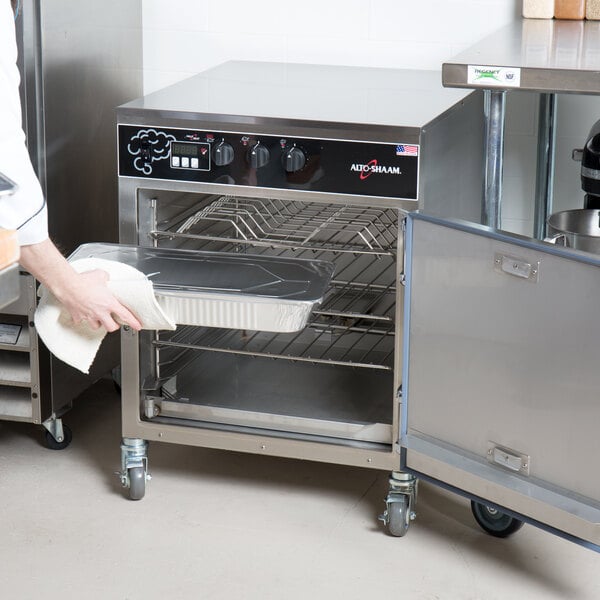
A cook and hold smoker oven can cook, roast, smoke, and hold your food until it’s ready to be served. Many come with a wood chip container or an accessory kit to hold wood chips, which will help meat obtain the smoky, savory flavor that is a staple of barbecue.
- Feature programmable digital controls and timer for ease of use
- Most have a cook and hold function that keeps your food hot automatically after it’s finished cooking
- Many can hold real wood chips to deliver a natural, smoky flavor
- Operate at lower temperatures than standard ovens, which helps reduce shrinkage
- Easy to clean and maintain
- Location: indoor use
- Fuel type: electricity
- Best for: operators who are new to barbecue or are looking to add barbecue to their menu
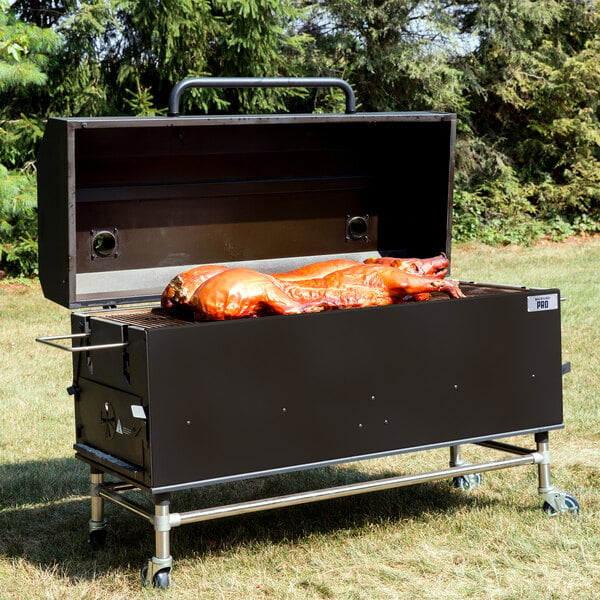
A smoker grill comes with a slide out tray for charcoal or wood chips as well as easy-to-read thermometers to monitor the temperature of your grill.
- Perfect for low and slow cooking and smoking
- Temperature will need to be regularly checked during the cooking process and manually adjusted when necessary
- Location: outdoor use
- Fuel type: charcoal, wood, and liquid propane
- Best for: catered events, tailgates, and outdoor venues
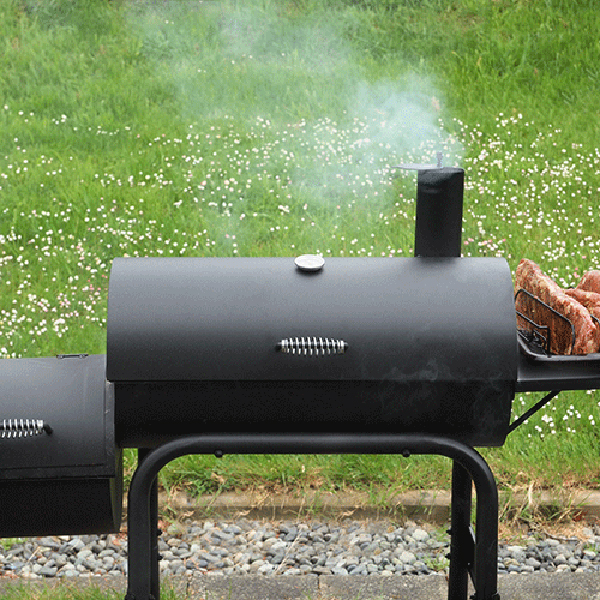
Offset Grill
Offset grills are one of the most traditional and authentic ways to smoke meat. They feature a firebox to hold the fuel, which is connected to a larger barrel where the cooking takes place. The firebox feeds smoke into the cooking chamber to give it that rich, authentic smoky flavor and crisp barbecued bark.
- Ideal for low and slow cooking and smoking
- Easy to adjust the heat and replenish fuel
- Can cook large amounts of food at once
- Temperature will need to be regularly checked during the cooking process and manually adjusted when necessary
- Location: outdoor use
- Fuel type: charcoal and wood
- Best for: BBQ joints, catered events, tailgates, and outdoor venues
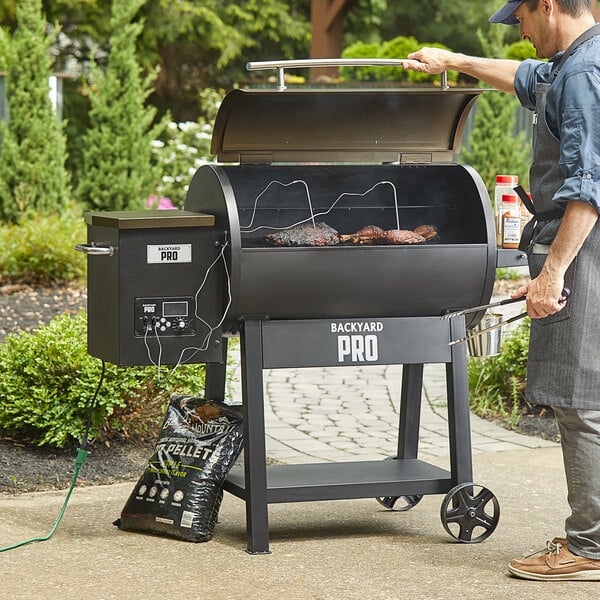
Pellet grills are one of the most versatile and easy-to-use smokers to cook with. They feature an easy-to-use digital control panel that allows you to set timers, monitor internal temperatures, and measure the temperature of meat with incredible precision. When choosing between a pellet grill and a vertical pellet smoker, a pellet grill is best for when you'd like to grill and sear with the same unit.
- Allows you to grill, sear, braise, roast, and smoke all with the same unit
- Provides more precise temperature control than smoker grills and offset grills for more evenly cooked and consistent-tasting meat
- Auger automatically feeds wood pellets from the hopper into the flavor chamber to be heated and turned into flavorful smoke
- Do not require as much cooking oversight as offset grills
- Can be very efficient in terms of fuel usage
- Require electricity to operate
- Food does not achieve as smoky of a flavor as it would when cooking with an offset grill
- Location: outdoor use
- Fuel type: wood pellets
- Best for: BBQ joints, catered events, tailgates, and outdoor venues

A vertical pellet smoker is designed to have food sit directly above the fuel source and have the chimney directly above the food. This allows for smoke to evenly distribute around the meat for an incredible, smoky flavor. When choosing between a vertical pellet smoker or a pellet grill, a vertical pellet smoker is best for when you desire low and slow smoking and a richer, smokier taste.
- Delivers a rich, smoky taste to meats
- Able to smoke, bake, braise, roast, and barbecue; cannot sear or grill
- Provides precise temperature and time control
- Features a spacious cooking area
- Large hopper allows for overnight cooking
- Require electricity to operate
- Location: outdoor use
- Fuel type: wood pellets
- Best for: BBQ joints, catered events, fairs, and outdoor venues
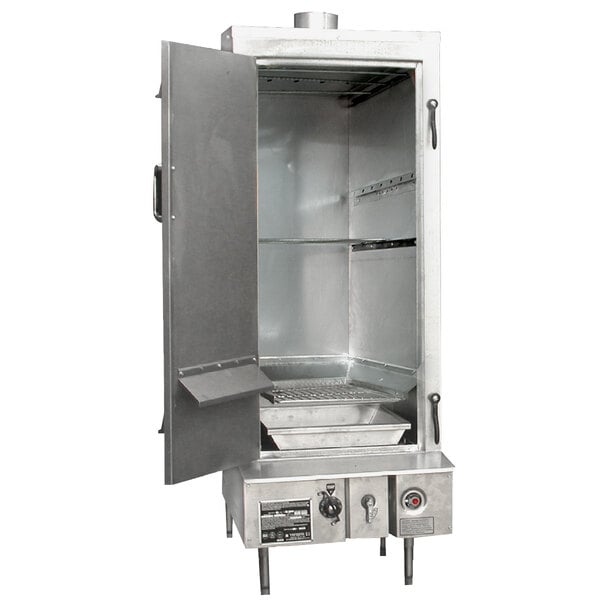
Indoor smokehouses are large, gas-powered units that utilize vertical space to maximize on capacity without taking up too much space in your kitchen. The units include skewers so that ribs, whole chickens, and tenderloin can be easily suspended for optimal cooking.
- Flavorful smoke is generated by the drip shields during the cooking process
- Each size can be used with a compatible rack kit that will convert the smokehouse into a vertical barbecue oven
- Doors can be either right or left hinged
- Location: indoor use
- Fuel type: natural gas or propane
- Best for: urban kitchens, ghost kitchens, and BBQ joints

Express Smoker
Proprietary to R & V works, express smokers feature a sealed pressure and vacuumed chamber that is coupled with a patented hydration regulator to smoke meats in a fraction of the time that conventional smokers require.
- Cooks baby back ribs in 35 to 40 minutes, a whole 3 lb. chicken in 30 minutes, and a 9 lb. brisket in 2 hours
- Location: outdoor use
- Fuel type: propane gas
- Best for: smokehouses, catered events, tailgates, and outdoor venues
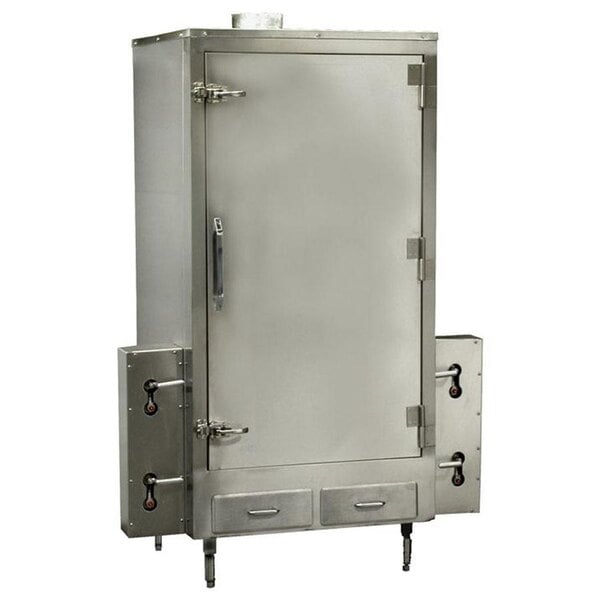
Indoor pig roasters are large enough to cook whole pigs or several racks of meat at one time, which makes them perfect for high-volume establishments. They are designed with two permimeter burns that spread heat throughout the roaster for even cooking and a crispy crust.
- Spacious enough to smoke a whole pig or duck
- Feature two perimeter burners to cook food evenly
- Smoke is generated by fat dripping onto the aluminized drip shields, which also protect the burners
- Location: indoor use
- Fuel type: natural gas
- Best for: urban kitchens, ghost kitchens, catering companies, and BBQ joints

A smoke gun is a handheld smoker tool that produces cold smoke to bring a smoky flavor to more delicate foods, such as cheese, chocolates, ice cream, and even cocktails.
- Infuses and finishes foods and drinks with smoky flavor and aroma
- Compact, portable, and easy to use
- Can be used in the back-of-house to cold smoke foods or for front-of-house display cooking to enhance your guests’ experience
- Battery-operated for convenience
- Location: indoor or outdoor use
- Best for: mixologists, chefs, and gastronomists

Combination ovens deliver many benefits to a commercial kitchen, including their ability to smoke, roast, steam, sous vide, braise, bake, rethermalize, and oven fry foods all in one unit, allowing you to save on the space and cost of a dedicated smoker for your kitchen. A combination oven uses three methods of cooking: convection, steam, and a combination of steam and convection. Like smoker ovens, many combi ovens can be used with a compatible smoker box that can hold wood chips to give meats an authentic smoky flavor.
- Allow you to offer smoked and barbecued foods on your menu without having a dedicated smoker
- Most combi ovens are programmable, allowing you to upload and download recipes
- Easy to use and clean
- Location: indoors
- Fuel type: electricity
- Best for: urban kitchens, restaurants, bars, and cafeterias
Commercial Smoker Fuel Types
There are six fuel types that are used in commercial smoking: wood, charcoal, wood pellets, electricity, natural gas, and propane. Wood and charcoal are the most popular and traditional fuel types used for smoking meats.
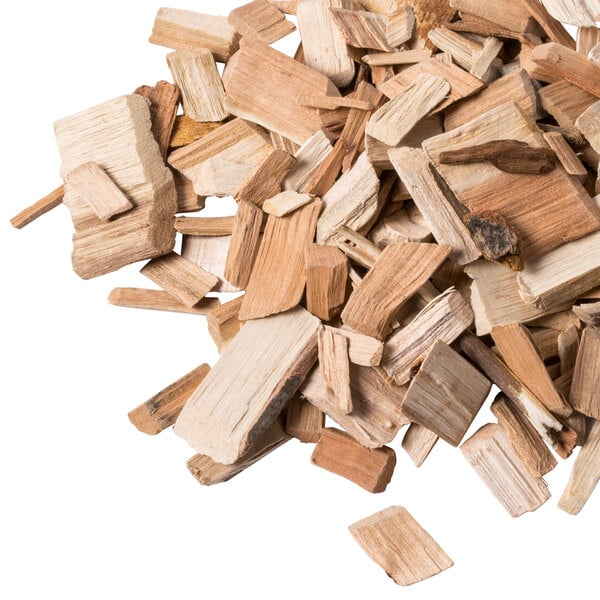

1. Wood
Available in either wood chips or wood logs, wood creates the maillard reaction to give meat that authentic, crispy bark and savory, smoky flavor.
- Gives meat a classic smoked flavor and perfectly crisp exterior
- Different wood varieties give off different flavors, thus providing versatility for your menu
- All-natural fuel source
- Using the wrong type of wood can deliver an overwhelming smoky flavor
- Requires a lot of oversight and can be difficult for entry-level chefs to master


2. Charcoal
Available in either hardwood lump charcoal or briquettes, charcoal is made by burning wood until it carbonizes. This allows it to burn at low or really high temperatures and produce a flavorful smoke.
- Has a longer burn time than wood
- Lights easily
- Ideal for both smoking and high-heat grilling
- Briquettes contains additives and fillers that can give food an "off" flavor
- Produces ash that needs to be cleaned up after cooking
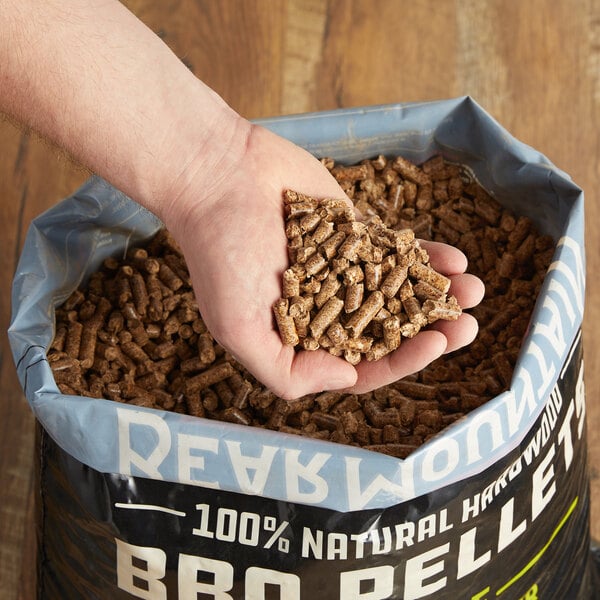

3. Wood Pellets
Speficially designed for use with pellet grills, wood pellets are made from 100% hardwoods that are compressed to have a low moisture content.
- Gives foods a rich, smoky flavor
- Different wood varieties give off different flavors, thus providing versatility for your menu
- Affordable fuel source
- Typically are all-natural
- Requires little to no oversight to use
- Using the wrong type of wood can deliver an overwhelming smoky flavor


4. Electricity
Electric smokers use electricity to heat an element that is located underneath a wood chip tray. While many electric smokers have a high upfront cost, they are energy efficient, easy to use, and are versatile to use, which can save on costs in the long run.
- Energy-efficient fuel source
- Set-and-forget controls make it easy to use
- Great for use in areas where fires aren't permitted
- Excellent for smoking more delicate foods like fish and cheese
- Requires wood chips to achieve smoky flavor
- Moisture inside the unit makes it harder to achieve a crisp crust
- Some models are hardwired and will require professional installation
- Typically are smaller and cannot hold a large amount of product
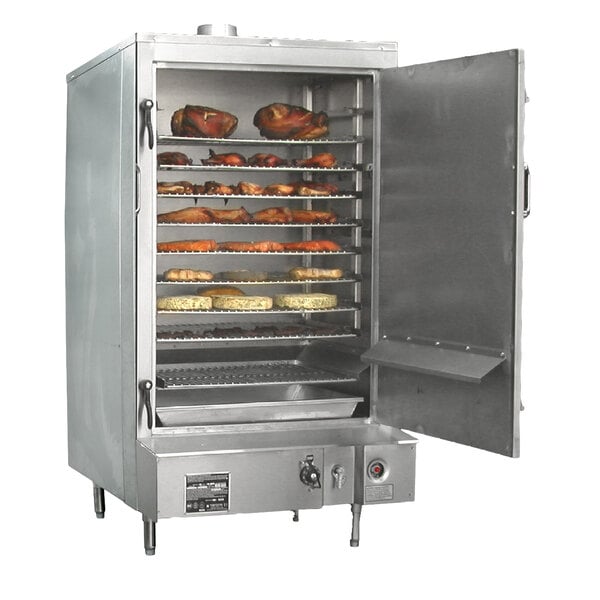

5. Natural Gas
Natural gas smokers are hooked up to a natural gas line, so they have a constant fuel source unlike propane smokers. To achieve a smoky flavor, wood chips must be added to a tray that typically sits above the heating element.
- Consistent heat source makes it easy to control temperatures
- Have a wide temperature range
- Large cooking capacity
- Require wood chips to achieve smoky flavor
- Must be professionally installed


6. Propane
Liquid propane smokers are a convenient, portable option for outdoor and off-site smoking. To achieve a smoky flavor, wood chips must be added to a tray that typically sits above the heating element.
- Have fast startup times
- Easy to use and maintain a consistent temperature
- Conveniently portable
- Require wood chips to achieve smoky flavor
- Propane tanks run out and have to be swapped
Related Resources
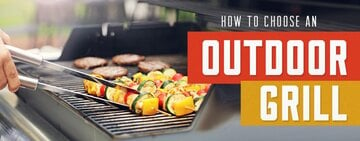
Outdoor Grill Buying Guide
Whether you're barbecuing meat or preparing hamburgers and hot dogs for your tailgate party, having the right outdoor grill for your menu and business model is imperative to successful grilling. This guide will go over the outdoor grill styles, grill sizes, and grill accessories needed so you can purchase the best grill for your establishment with confidence. Shop All Outdoor Grills Use the following links to navigate this guide and learn more about outdoor grills: Types of Outdoor Grills Charcoal vs Gas Grills Grill Dimensions BTUs for a Gas Grill Grilling Accessories
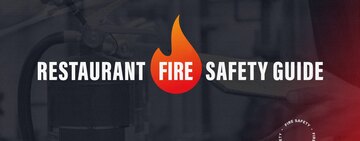
Restaurant Fire Safety
Fire safety is a critical concept for any restaurant to grasp because doing so can prevent thousands of dollars of damages and serious injuries. Unfortunately, the majority of commercial fires occur in restaurants due to the variety of flammable objects found in active kitchens. Understanding how to prevent restaurant fires and what to do when an uncontrollable fire breaks out helps mitigate damages and potentially saves lives. Preparing your restaurant for fire prevention and response can be tricky, so if you're looking for tips to improve your restaurant's safety , check out this comprehensive guide on restaurant fire safety. Looking for fire safety supplies for your restaurant? Click below. Shop All Fire Safety Equipment Use these links
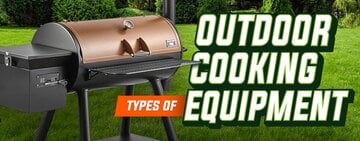
Outdoor Cooking Equipment Buying Guide
One of the most enjoyable parts of summer is taking advantage of the warm weather and cooking outside. Grilling burgers, smoking ribs, or even cooking eggs on an outdoor griddle allows you and your guests to enjoy the great weather and a delicious meal simultaneously. Whether you're looking to make some new additions to your outdoor dining space or spicing things up with a new outdoor kitchen , look no further. Our commercial outdoor cooking equipment buying guide will help you find what you need to start making all your favorite summertime staples. Shop All Outdoor Cooking Equipment Use the following links to learn about types of outdoor cooking equipment: Outdoor Grills Outdoor Pizza Ovens Outdoor Griddles Outdoor Smokers Outdoor Deep Fry
- Topics 1346
- Industrial 55
- Troubleshooting Guides 21
- Restaurant Management 128
- Bar Management 55
- Catering Tips 35
- Bakery Management 42
- Food Trucks & Concessions 49
- Advertising & Marketing 37
- Eco-Friendly Tips 11
- Facility Layout & Design 41
- Coffee Shop Tips 28
- Installation & Maintenance 51
- Janitorial & Pest Control 30
- Safety & Sanitation 88
- Startup Tips 104
- Menu Design 10
- Kitchen & Cooking Tips 81
- Hospitality Management 23
- Pizza & Sandwich Shop Tips 36
- Smallwares 37
- Food Prep 88
- Tabletop Items 17
- Disposables 22
- Calculators & Tools 6
- Consumables 52
- Warewashing & Laundry 18
- Cooking Equipment 90
- Food Storage & Refrigeration 51
- Beverage Equipment 34
- Office Supplies 6
- Resource Type
- In-Depth Articles272
- Buying Guides296
- How-Tos93
- Product Reviews77


